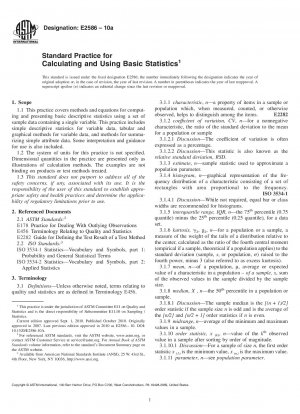ASTM E2586-10a
Standard Practice for Calculating and Using Basic Statistics
- Standard No.
- ASTM E2586-10a
- Release Date
- 2010
- Published By
- American Society for Testing and Materials (ASTM)
- Status
- Replace By
- ASTM E2586-12
- Latest
- ASTM E2586-19e1
- Scope
This practice provides approaches for characterizing a sample of n observations that arrive in the form of a data set. Large data sets from organizations, businesses, and governmental agencies exist in the form of records and other empirical observations. Research institutions and laboratories at universities, government agencies, and the private sector also generate considerable amounts of empirical data.
A data set containing a single variable usually consists of a column of numbers. Each row is a separate observation or instance of measurement of the variable. The numbers themselves are the result of applying the measurement process to the variable being studied or observed. We may refer to each observation of a variable as an item in the data set. In many situations, there may be several variables defined for study.
The sample is selected from a larger set called the population. The population can be a finite set of items, a very large or essentially unlimited set of items, or a process. In a process, the items originate over time and the population is dynamic, continuing to emerge and possibly change over time. Sample data serve as representatives of the population from which the sample originates. It is the population that is of primary interest in any particular study.
The data (measurements and observations) may be of the variable type or the simple attribute type. In the case of attributes, the data may be either binary trials or a count of a defined event over some interval (time, space, volume, weight, or area). Binary trials consist of a sequence of 0s and 1s in which a “1” indicates that the inspected item exhibited the attribute being studied and a “0” indicates the item did not exhibit the attribute. Each inspection item is assigned either a “0” or a “1.” Such data are often governed by the binomial distribution. For a count of events over some interval, the number of times the event is observed on the inspection interval is recorded for each of n inspection intervals. The Poisson distribution often governs counting events over an interval.
For sample data to be used to draw conclusions about the population, the process of sampling and data collection must be considered, at least potentially, repeatable. Descriptive statistics are calculated using real sample data that will vary in repeating the sampling process. As such, a statistic is a random variable subject to variation in its own right. The sample statistic usually has a corresponding parameter in the population that is unknown (see Section 5). The point of using a statistic is to summarize the data set and estimate a corresponding population characteristic or parameter.
1.1 This practice covers methods and equations for computing and presenting basic descriptive statistics using a set of sample data containing a single variable. This practice includes simple descriptive statistics for variable data, tabular and graphical methods for variable data, and methods for summarizing simple attribute data. Some interpretation and guidance for use is also included.
1.2 The system of units for this practice is not specified. Dimensional quantities in the practice are presented only as illustrations of calculation methods. The examples are not binding on products or test methods treated.
1.3 This standard does not purport to address all of the safety concerns, if any, associated with its use. It is the responsibility of the user of......
ASTM E2586-10a Referenced Document
- ASTM E178 Standard Practice for Dealing With Outlying Observations
- ASTM E2282 Standard Guide for Defining the Test Result of a Test Method
- ASTM E456 Standard Terminology for Relating to Quality and Statistics
- ISO 3534-1 Statistics — Vocabulary and symbols — Part 1: General statistical terms and terms used in probability
- ISO 3534-2 Statistics - Vocabulary and symbols - Part 2: Applied statistics
ASTM E2586-10a history
- 2019 ASTM E2586-19e1 Standard Practice for Calculating and Using Basic Statistics
- 2019 ASTM E2586-19 Standard Practice for Calculating and Using Basic Statistics
- 2018 ASTM E2586-18 Standard Practice for Calculating and Using Basic Statistics
- 2016 ASTM E2586-16 Standard Practice for Calculating and Using Basic Statistics
- 2014 ASTM E2586-14 Standard Practice for Calculating and Using Basic Statistics
- 2013 ASTM E2586-13 Standard Practice for Calculating and Using Basic Statistics
- 2012 ASTM E2586-12b Standard Practice for Calculating and Using Basic Statistics
- 2012 ASTM E2586-12a Standard Practice for Calculating and Using Basic Statistics
- 2012 ASTM E2586-12 Standard Practice for Calculating and Using Basic Statistics
- 2010 ASTM E2586-10a Standard Practice for Calculating and Using Basic Statistics
- 2010 ASTM E2586-10 Standard Practice for Calculating and Using Basic Statistics
- 2007 ASTM E2586-07 Standard Practice for Calculating and Using Basic Statistics
